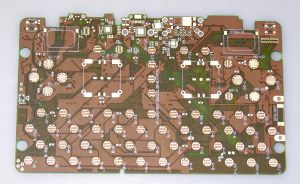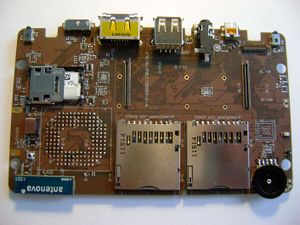Mainboard: Difference between revisions
Gorillazero (talk | contribs) m (→I²C connectivity: added link to sensors wiki-page) |
(→Modem: Adding GPS hardware links) |
||
| (3 intermediate revisions by 2 users not shown) | |||
| Line 1: | Line 1: | ||
This is the largest PCB in the Pyra, with a wide range of different functions. It could be compared to the motherboard in a traditional desktop computer, with the addition of a keyboard and gaming controls on one side. Display-support hardware (the [[Displayboard]]) and the processor itself (see [[CPU-Board]]) are each on separate PCBs. | <onlyinclude>This is the largest PCB in the Pyra, with a wide range of different functions. It could be compared to the motherboard in a traditional desktop computer, with the addition of a keyboard and gaming controls on one side. Display-support hardware (the [[Displayboard]]) and the processor itself (see [[CPU-Board]]) are each on separate PCBs.</onlyinclude> | ||
The Mainboard includes the following hardware: | The Mainboard includes the following hardware: | ||
==[[Modem]]== | ==[[Modem]]== | ||
''Main Article: [[Modem]]'' | |||
There is a space for an optional [[Modem|WWAN&GPS]] module. This will be populated with various Pin-compatible Modules designed for different Regions, or not at all, depending on which Pyra Model you buy. | There is a space for an optional [[Modem|WWAN&GPS]] module. This will be populated with various Pin-compatible Modules designed for different Regions, or not at all, depending on which Pyra Model you buy. | ||
GPS Hardware: | |||
* [https://www.digikey.com/htmldatasheets/production/1247805/0/0/1/bgm1034n7.html Infineon BGM1034N7] - GPS and GLONASS Front-End Module, a low-noise filter and pre-ampliflier (LNA) | |||
* The actual GPS/GLONASS receiver is part of the modem chip. | |||
[[image:Pyra_PCB_baredev.jpg|thumb|Unpopulated development version]] | [[image:Pyra_PCB_baredev.jpg|thumb|Unpopulated development version]] | ||
| Line 13: | Line 19: | ||
Haptic feedback is provided through vibration generated by an electric Motor with an unbalanced mass on its Driveshaft. | Haptic feedback is provided through vibration generated by an electric Motor with an unbalanced mass on its Driveshaft. | ||
[http://boards.openpandora.org/uploads/post-1-0-32618500-1406479444.jpeg] | [http://boards.openpandora.org/uploads/post-1-0-32618500-1406479444.jpeg] | ||
Hardware: | |||
* [https://www.precisionmicrodrives.com/product/304-106-5mm-vibration-motor-7mm-type Precision Micro 304-106] - 5mm x 7mm vibration motor, 3V @ 37.5mA, 9500rpm, 0.6g amplitude | |||
==[[Storage]]== | ==[[Storage]]== | ||
Latest revision as of 21:26, 1 April 2021
This is the largest PCB in the Pyra, with a wide range of different functions. It could be compared to the motherboard in a traditional desktop computer, with the addition of a keyboard and gaming controls on one side. Display-support hardware (the Displayboard) and the processor itself (see CPU-Board) are each on separate PCBs.
The Mainboard includes the following hardware:
Modem
Main Article: Modem
There is a space for an optional WWAN&GPS module. This will be populated with various Pin-compatible Modules designed for different Regions, or not at all, depending on which Pyra Model you buy.
GPS Hardware:
- Infineon BGM1034N7 - GPS and GLONASS Front-End Module, a low-noise filter and pre-ampliflier (LNA)
- The actual GPS/GLONASS receiver is part of the modem chip.



Rumble
Haptic feedback is provided through vibration generated by an electric Motor with an unbalanced mass on its Driveshaft. [1]
Hardware:
- Precision Micro 304-106 - 5mm x 7mm vibration motor, 3V @ 37.5mA, 9500rpm, 0.6g amplitude
Storage
Main Article: Storage
The Mainboard includes a combination microSD/SIM card slot which, with the addition of a microSD card, can be used for internal storage up to 200GB. With the addition of two accessible regular-sized SD card slots (each capable of up to 512GB storage), that's 1.2 TB of removable storage.
Connectivity
The Pyra connects to WWAN&GPS, WiFi and Bluetooth from Modules on the Mainboard.
I²C connectivity
The Pyra mainboard contains several I²C busses. 4 of them travel through the mainboard and are accessible from them.
The following devices are connected to I²C.
| SYSTEM | SMBus, I/O Expander | LED Driver | Audio Sense | |
| TCA6424ARGJ | IS31FL3199 | TS3A227ERVAR | ||
| SENSOR | Gyroscope | Compass, Accellerometer | Barometer, Thermometer, Hygrometer (only 4G) | |
| BMG160 | BMC150 | BME280 | ||
| PERIPHERAL | Hall Effect Sensor (Left joystick) | Hall Effect Sensor (Right joystick) | Battery charger | Modem current sensor (Only 4G) |
| AS5013 | AS5013 | BQ24297RGE | INA231YFF | |
| PANEL | Touch screen controller | LED Driver | ||
| TSC2007IPW | IS31FL3196 |